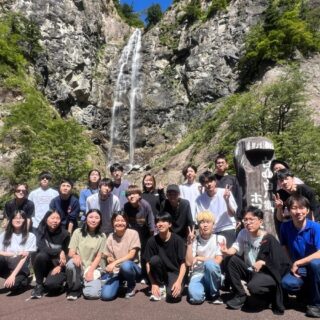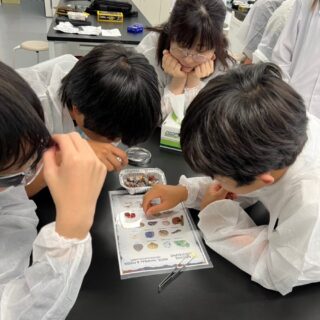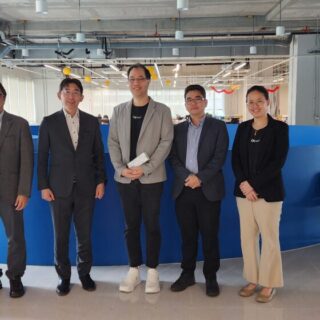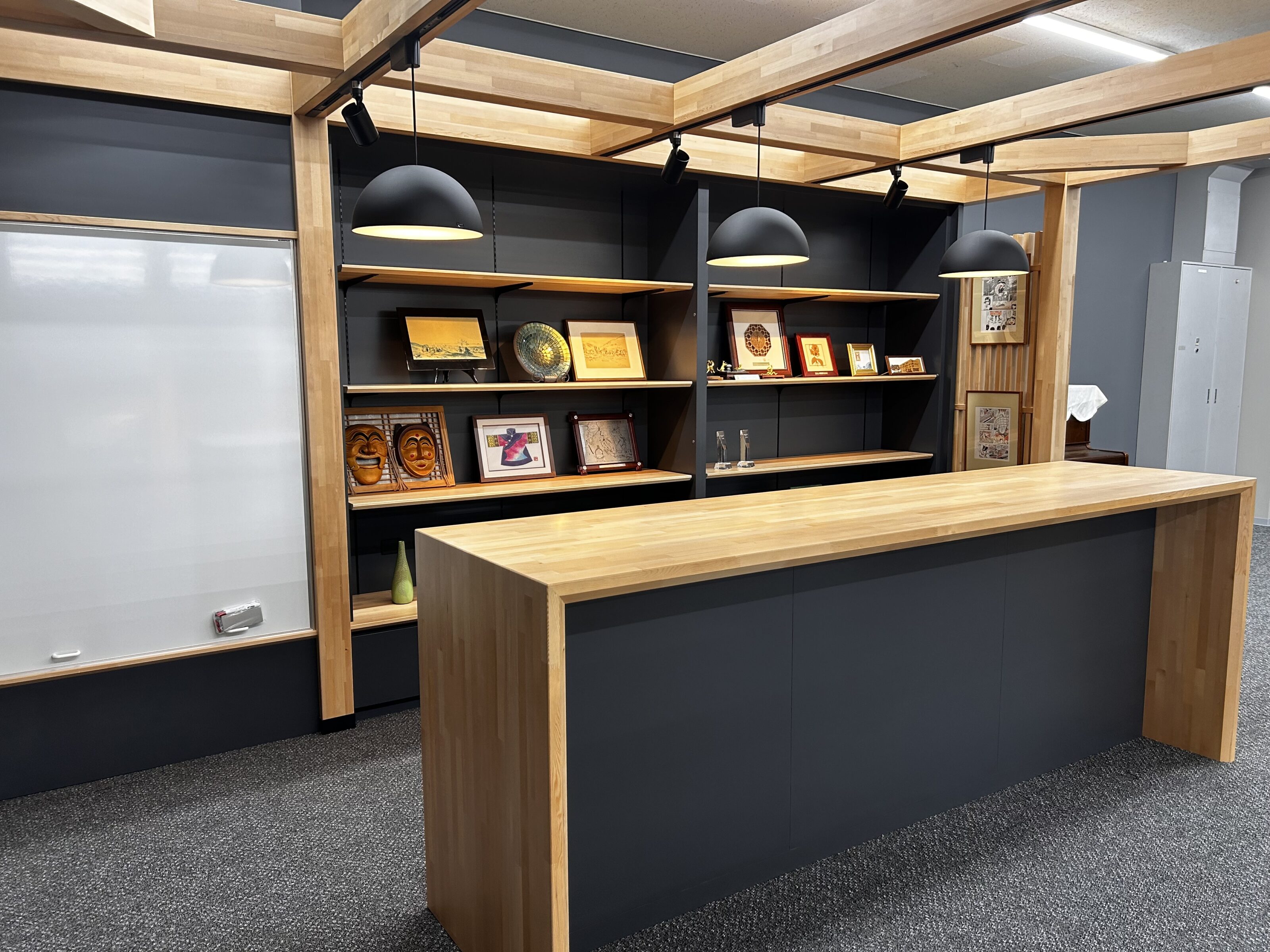
Hello everyone! The 1st year homeroom and STEM class teacher, Brandon Wohlfarth, here to tell you about our trip with the 1st and 2nd year students on the Hakusan Shirakawa-go White Road on Friday September 20th, 2024. For those who do not know, Hakusan Shirakawa-go White Road is a famous sightseeing spot in the HAKUSANROKU (Foothills of Mt. Hakusan) area during the fall and summer. It is a beautiful stretch of road with various scenic photo spots where you can experience the wonderful expanse of nature, go hiking, or just enjoy a casual drive through nature. The original plan was to go for a hike through the woods along the White Road; however, due to the chance of rain that was forecasted for that day, we adjusted our plan to be a bus tour along the road instead. Even though we had planned for rain, it ended up being a beautiful, extremely hot day.
Our first stop along the White Road was a lookout point at the top of a mountain that separated Ishikawa and Gifu Prefectures. There, students could walk around the viewing area, take pictures on a swing that overlooked Gifu, or enjoy a snack or drink at a local shop. Seeing the students chatting, enjoying nature, and taking pictures of the spectacular view was wonderful.
After this, we returned to the bus and traveled to a waterfall along the road. Here we took class pictures! This was only a brief stop just to see the waterfall, and we then continued to our last stop, the Chugu Onsen Visitor Center. Here, some students looked at the nature of HAKUSAN (Foothills of Mt. Hakusan) exhibits, while others went to the nearby river to play and skip stones. The students here really enjoyed the time they spent outside and playing by the river. Phillip Cadzow sensei even convinced some students to wade into the water with him. After that, the students returned to the bus, and we returned to ICT. I hope that the students were able to have some fun and enjoy their morning in nature, that we get to experience every day here at the Hakusanroku Campus.
Brandon Wohlfarth
 Hello, everyone. I'm Meguru Ito, one of the physics teachers at ICT. This year, the STEM Fair was held on Wednesday September 18th, 2024, for the 1st year students, and on Wednesday September 25th, for the 2nd year students. The STEM Fair is an annual event held in mid-September, where students present the results of their Summer STEM Project, which is given as a summer assignment at ICT. In simpler terms, it’s a presentation of their summer independent research, but the students create posters in English and give their presentations in English, making it quite a challenging event. I envisioned it as something similar to a science fair, where students at schools abroad present their research, and hoped we could create a similar festive atmosphere when we started this at the Hakusanroku campus.
Hello, everyone. I'm Meguru Ito, one of the physics teachers at ICT. This year, the STEM Fair was held on Wednesday September 18th, 2024, for the 1st year students, and on Wednesday September 25th, for the 2nd year students. The STEM Fair is an annual event held in mid-September, where students present the results of their Summer STEM Project, which is given as a summer assignment at ICT. In simpler terms, it’s a presentation of their summer independent research, but the students create posters in English and give their presentations in English, making it quite a challenging event. I envisioned it as something similar to a science fair, where students at schools abroad present their research, and hoped we could create a similar festive atmosphere when we started this at the Hakusanroku campus.
Last year, in the Hakusanroku Journal , I introduced the origins of the STEM Fair and rules of the fair, so this year I would like to give a general review of the 2nd year students' presentations.
Additionally, this year, we were finally able to reinstate the "Overseas English Program,” a short-term study abroad course for 2nd year students during the summer vacation. Seven students participated in three-week language training programs overseas during their summer break. Since the three-week program uses almost all of the summer vacation period, I thought it would be too difficult for the students to do the STEM Project, so I excused them from STEM projects. Instead, they conducted a “Debriefing Session of the Overseas English Program” at the same time as the STEM Fair. I was a little worried because there would be fewer students presenting at the STEM Fair, but they all gave presentations that blew those worries away.
For the 2nd year students, I required them to write a proposal, collect data and give a poster presentation. For the presentation, they had to include tables and graphs on their posters as well as explain what they did so that everyone could understand the purpose of their research.
What struck me the most this time was that many students presented topics and data from fields I wasn't familiar with, which made listening to all the presentations highly engaging. I was particularly impressed by Mitsuki Ohta, a 2nd year student who won the Best Presentation Award, for creating his own wind tunnel experiment equipment. His dedication was truly remarkable. Incidentally, Mitsuki Ohta also placed 2nd last year, and his brother, Haruki Ohta, a 3rd year student, has consistently placed 1st in past STEM Fairs. They are a family of top performers in the competition.
I was also impressed by the significant evolution of the 2nd year students since last year. It was clear from their presentations how much effort and time they invested in this STEM project. Compared to last year's presentations, many students demonstrated a remarkable improvement in quality. Their familiarity with the tasks and presentations played a role in this enhancement, highlighting the effectiveness of the education at the ICT.
I may have mentioned this before, but to be honest, I haven't really provided much direct guidance myself. However, thanks to the students' efforts and the support of the faculty, I believe the STEM Fair has become a signature event at ICT. As the number of students increases, we may need to change the way presentations are conducted, which could add to the faculty's workload. Nonetheless, I truly love the students' unique projects, and I hope we can continue this project. In the future, I would like to invite not only some of the faculty members from the Hakusanroku Campus, but also students, teachers and staff from Kanazawa campus as well. (Though the students might not be thrilled about it!)
Meguru Ito
 Hello, This is Yuri Makada from the Hakusanroku Office.
Hello, This is Yuri Makada from the Hakusanroku Office.
From Tuesday, August 6th, 2024, to Thursday, August 8th, 2024, the Summer Camp 2024 was held at the Hakusanroku Campus. A total of 29 junior high school students, ranging from 1st to 3rd year, participated in the 3-day, 2-night camp. The participants worked on a single project, from brainstorming ideas to prototyping and giving presentations. They learned in English through Engineering Design and STEAM Education, which is implemented by ICT using Design Thinking.
Day 1: Tuesday, August 6th, 2024
In the morning, after greetings from President Masaaki Shikada and Vice President Mamoru Mukai, Omihito Matsushita sensei gave an introduction in English about the unique features of ICT, such as STEAM Education and Engineering Design Education.
After lunch, an icebreaker activity was held. First, the students asked each other questions about their hobbies and favorite colors. Then, they introduced themselves in front of everyone, and the other students had to judge whether the information was true or not, raising a “×” for false and a “✓” for true. Next, the students were divided into groups and played a game where they had to guide a ball into a designated area. One person was blindfolded, while the other three took on the role of giving instructions, helping to develop their teamwork skills.
After that, the students returned to the classroom, where the project theme, "Imagineering a Dream Company Aimed at the Future We Want to See!!” was announced. In recent years, while the concept of a corporate purpose or vision statement is becoming more of a reason to choose to work at a particular company, many young students tend to be attracted to tangible factors like company names and salaries when choosing their careers. Therefore, this project involved a workshop aimed at helping students understand the importance of the role that companies should play in society. The workshop was divided into two main phases. During the first phase on the first day, students explored why certain everyday social issues are considered problems. They deepened their understanding of the core of these issues and used "Why" questions to investigate the root causes, ultimately identifying the real challenges. From there, they generated specific solutions to address these problems.
In the evening, a Thai Kite Making activity was held together with the students from the Global Summer Camp, which was being held simultaneously at the Hakusanroku Campus. The students were divided into groups consisting of both Summer Camp and Global Summer Camp participants, and under the guidance of Lapananrat Pantawat, a 1st year student from Thailand, they used paper and bamboo to build kite. After designing the kites, they enjoyed flying them in the courtyard of the Hakusanroku Campus. Later, the students participated in a bouldering activity.
-
鹿田校長より挨拶 Greetings from President Masaaki Shikada
-
学生寮に移動中 Moving to the student dormitory
-
昼食 Lunch Time
-
自己紹介し合う様子 Introducing themselves to each other
-
ボールを指定されたエリアに入れるというゲーム A game in which the ball is placed in a designated area
-
社会問題を選ぶ Choose the social issue topic
-
なぜこの問題がより深刻化するのか議論 Discuss why this issue becomes more problematic?
-
Why質問を通じてその根本原因を深掘りし、真の問題点を明らかにする Discuss insight problems
-
「タイの凧作り」 Thai Kite Making activity
-
国際高専1年生のLapananrat Pantawatさんの指導のもと「タイの凧作り」 Thai Kite Making activity guidance of Lapananrat Pantawat, a 1st year student from Thailand.
-
ボルダリング体験 Bouldering activity
-
夜のフリータイム Night free time
-
夜のフリータイム Night free time
Day 2: Wednesday, August 7th, 2024
In the morning, as part of the English activities, a game called Running Telephone was held. The first student in each group was given an English sentence, which they had to memorize and accurately pass on to the next person. The last student had to deliver the message exactly as it was first relayed to the teacher. The students’ ability to memorize the sentences perfectly was impressive. The smooth communication made everyone appreciate their focus and memory skills.
After that, an idea generation activity called My Worst Idea was conducted. Each group was given items such as boxing gloves, ab rollers, and jump ropes, and had to present the worst possible way to use these items.
Afterwards, the project activities continued from the previous day. In the second phase of the workshop, the focus was on the companies that would implement the generated solution ideas. The students examined how these ideas could be applied to solve real-world social issues. They also delved deeper into the purpose (the reason for a company's existence in society) underlying the solutions. Additionally, to further clarify the company’s impact and significance in society, the students considered the company’s logo and slogan as well.
After that, students conducted an experiment on crystals as part of the STEAM Science Experiment. First, the students played a game where they searched for mineral crystals, such as quartz, with distinctive appearances among a variety of stones. Following this, they attended a lecture on the structures of crystals found in everyday objects and chemical substances. Afterward, they observed recrystallized chemical substances under a microscope, examining the shapes of the crystals and how they sparkled with colors when viewed through a polarizing filter. Finally, using beads, the students created keychains inspired by the crystal structures of chemical substances.
-
ランニング・テレフォン Running Telephone
-
ランニング・テレフォン Running Telephone
-
「私の最悪のアイデア」活動 An idea generation activity called My Worst Idea
-
「私の最悪のアイデア」活動 An idea generation activity called My Worst Idea
-
ワークショップの「第2フェーズ」 In the second phase of the workshop
-
会社のスローガンについて Company Logo
-
会社のロゴについて Company Slogan
-
チームロゴをデザイン Design a team logo
-
チームロゴをデザイン Design a team logo
-
チームのロゴおよびスローガン入りTシャツ完成!They created team-specific T-shirts with logos and slogans.
-
STEAM科学実験 STEAM Science Experiment
Day 3: Thursday, August 8th, 2024
The first activity of the day was called Penguin Line, where students practiced communication using various methods. This activity aimed to strengthen team unity in preparation for the final presentations and rehearsals.
In the final presentations, many parents gathered at the Hakusanroku Campus to witness the students' achievements. The students presented their ideas in English based on the theme “Imagineering a Dream Company Aimed at the Future We Want to See!!” Their presentations included the social issues they focused on, the challenges arising from these issues, an analysis of the causes, and two proposed solutions. In addition, students introduced the name of the company that would provide these solutions, the company’s purpose and mission, and its logo and slogan, offering concrete solutions to the social problems.
After the presentations, the parents voted on the most outstanding team in a mock investment session. As a result, two teams were selected for an Excellence Award, and ICT Coins (certificates) were presented.
-
ペンギンライン Penguin Line
-
最終プレゼンテーション司会を務めたドミソン・アブワン先生、クリシア・アティロ先生 The final presentation will be hosted by Domyson Abuan sensei and Krishia Atillo sensei
-
Team P6, Topic: Lack of sleep
-
Team TSK2, Topic: Disparity by Meritocracy (In Academic levels)
-
Team RYMSH, Topic: Wildlife nuisance
-
Team Hachapy, Topic: Distracted while walking
-
Team Pentagram, Topic: SNS slander
-
Team IKYKH, Topic: Lack of exercise
-
コイン(表彰状)が授与 ICT Coins (certificates) were awarded.
The Summer Camp brought together participants from diverse backgrounds, differing in age, school, and hometown, allowing them to share ideas from various perspectives based on their unique knowledge and experiences. The thinking methods, processes for generating new value, and experiences of collaborative creation and storytelling will undoubtedly be valuable for the students in their future learning. I hope that many of them found this experience inspiring and that it will lead them to consider enrolling in ICT.
Yuri Makada
 Hello, my name is Yuri Makada from the Hakusanroku office. From Monday, August 26th to Monday September 2nd, 2024, I traveled to Bangkok, Thailand, for a business trip to recruit future ICT students, along with Mr. Tossa Mebusaya sensei, Mr. Rikichi Izumiya, the Deputy Secretary General of the ICT office, and Ms. Rattiya Mebusaya. I had the impression that Thailand would be extremely hot, but since Ishikawa Prefecture also experienced a heatwave of over 35 ℃ the week before, the temperature and humidity were almost the same. I had heard that August is the rainy season in Thailand, characterized by heavy downpours, but fortunately, we were blessed with sunny weather without being caught in any heavy rain.
Hello, my name is Yuri Makada from the Hakusanroku office. From Monday, August 26th to Monday September 2nd, 2024, I traveled to Bangkok, Thailand, for a business trip to recruit future ICT students, along with Mr. Tossa Mebusaya sensei, Mr. Rikichi Izumiya, the Deputy Secretary General of the ICT office, and Ms. Rattiya Mebusaya. I had the impression that Thailand would be extremely hot, but since Ishikawa Prefecture also experienced a heatwave of over 35 ℃ the week before, the temperature and humidity were almost the same. I had heard that August is the rainy season in Thailand, characterized by heavy downpours, but fortunately, we were blessed with sunny weather without being caught in any heavy rain.
From Monday, August 26th to Friday August 30th, 2024, we visited several institutions in Bangkok. Among them were the Bangkok Japanese School, Japanese cram schools, the Japanese Embassy, Kosen Kmutt, King Mongkut’s University of Technology Thonburi and its affiliated startup institution (Knowledge Xchange), and Sripatum University. During these visits, we introduced our school, discussed the recruitment of international students and returnees, toured the facilities of each institution, and exchanged opinions on the COOP Project and startup initiatives.
-
タイ高専訪問 Visited Kosen Kmutt
-
モンクット王工科大学トンブリー校でスタートアップ事業の意見交換 Discussion on startup business at King Mongkut’s University of Technology Thonburi
-
スタートアップ機関(Knowledge Xchange)の施設見学 Tour of facilities of a startup initiatives (Knowledge Xchange)
-
スィーパトゥム大学で「コーオププロジェクト」(Coop Project)およびスタートアップ事業の意見交換 Discussion on Coop Project and startup projects at the Sripatum University
-
スィーパトゥム大学の日本語専攻の学生が流暢な日本語で学校紹介 Introduction of the school in fluent Japanese by a student majoring in Japanese language at the Sripatum University
From Friday, August 30th to Sunday September 1st, the Bangkok Japan Expo 2024 was held. At the Expo, the 45th Bangkok Study Abroad Fair was also held by the Jeducation Bangkok Japan Expo Executive Committee. ICT had a booth at the event. At the Bangkok Japan Expo 2024, many booths showcased various aspects of Japanese culture, such as travel to Japan and Japanese culinary traditions, creating an atmosphere filled with enthusiasm and interest in Japan.
Many Japanese children living in Thailand, as well as Thai middle school students and their parents, visited the ICT booth. Some families engaged in serious discussions about studying at ICT for over an hour. Additionally, many high school and university students expressed strong interest in KIT, our affiliated school, and numerous questions were asked.
At the Bangkok Japan Expo 2024, there were a total of 118,104 visitors over 3 days. Many attendees already had an interest in Japan, which created an environment conducive to discussions about Japan and studying abroad. The ICT booth was bustling with visitors from morning until evening, and our team worked together to assist them. We were amazed by the high level of interest from the Thai people in studying in Japan. We hope that this exhibition will lead to increased enrollment at ICT.
This trip to Thailand was filled with new experiences, making it a very fulfilling time. Unfortunately, I had case of food poisoning and had to visit a hospital in Thailand, which was quite challenging. Despite this, the trip to Thailand was an unforgettable experience.
Yuri Makada
 Hello, this is Hitomi Nanto from ICT Kanazawa Office. Today, I am introducing our facility,” The Learning Commons”.
Hello, this is Hitomi Nanto from ICT Kanazawa Office. Today, I am introducing our facility,” The Learning Commons”.
The Learning Commons was launched on the first floor of the Kanazawa Campus in September 2023. This room is a large learning space for independent learning activities such as self-learning, group studying, preparation of presentations, and discussion. It is mainly used by 4th and 5th year students who commute to the Kanazawa Campus and is designed to help them spend their precious free time after school.
Students at ICT can use this room freely which contains interactive and movable whiteboards and multi-purpose outlets on the tables. After school, I often see students sitting in the box seats by the window, enjoying self-study and conversation with their classmates. It is exciting to think that we can spend time with our friends and create new possibilities together in a place like this.
Tables and chairs in the middle of this room can be used not only for self-study but also for group work by rearranging the tables. Movable whiteboards and projectors can be used for seminars, workshops, and group brainstorming sessions.
These are booth seats like those in a diner. Some students can be seen relaxing with their classmates, spreading out their lunch boxes and snacks, or engaging in self-study. The center of the table is equipped with an electrical multi-purpose outlet, which is very convenient for charging computers and tablets.
This is the counter area and a casual space for learning and discussion. Large displays and whiteboards on the walls can be used for effective group study and discussion by displaying images from PCs.
Hitomi Nanto





































































































